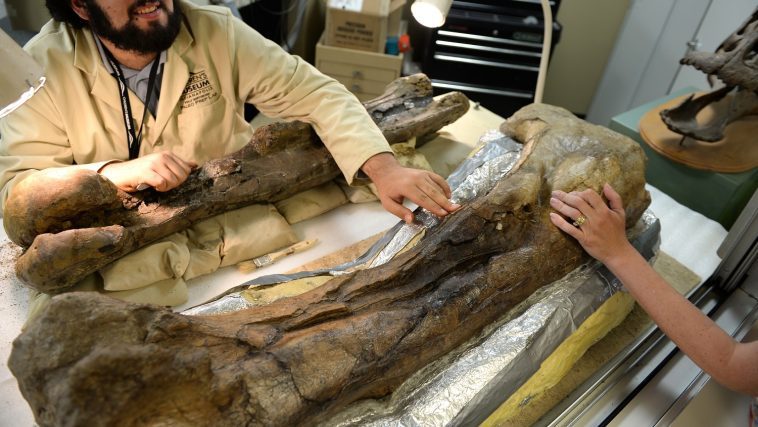[Originally published in 2015 as More Reasons To Doubt Iron as a Preservative for Dinosaur Tissue]
In 2005, Dr. Mary Schweitzer stunned the scientific community by finding what appeared to be soft tissue in a Tyrannosaurus rex fossil that is supposed to be 68 million years old.1 Since then, many such discoveries have been made (see here, here, here, here, and here), and a recent study indicates that soft tissue is probably quite common in dinosaur fossils. It is obviously hard to understand how soft tissue could remain in a fossil for millions of years, so those who are forced to believe that these fossils are millions of years old have tried to figure out some chemical mechanism that would prevent the decay of tissue for such an incredibly long time.
Two years ago, Dr. Schweitzer herself proposed such a mechanism.2 After studying the soft tissue from both the Tyrannosaurus rex and a Brachylophosaurus canadensis fossil, she and her team noticed that the structures that appeared to be blood vessels had iron particles embedded in them. They proposed that iron and oxygen could work together to prevent soft tissue decay, and they even did a two-year experiment with ostrich blood vessels to support their hypothesis.
I wrote about that paper after I read it, and in my analysis, I listed three reasons I was skeptical of their proposed mechanism. Two chemists who know much more about this kind of chemistry than I have written a detailed paper in the latest issue of Creation Science Research Quarterly, and in my opinion, they make it clear that Schweitzer’s proposed mechanism simply isn’t consistent with the data she collected.3
Dr. John M. DeMassa has a Ph.D. in organic chemistry from the University of Massachusetts Amherst and a Master of Divinity from Liberty University. His full-time job is designing antioxidants, but he is also a part-time preacher. He teamed up with Dr. Edward Boudreaux, who has a Ph.D. in theoretical chemistry from Tulane and has spent most of his career as a professor of chemistry at the University of New Orleans but has since retired. They teamed up to analyze the chemistry required for Schweitzer’s proposed mechanism to work. In the end, they conclude that the mechanism would have destroyed some of the chemicals that Schweitzer’s team found in their samples.
For example, in the Brachylophosaurus canadensis fossil, chemical analysis revealed fragments of proteins that included the amino acid known as asparagine, which we know is unstable in the presence of water. However, in order for Schweitzer’s proposed mechanism to work, water must deliver the iron and other key ingredients to the tissue. If that had actually occurred, you wouldn’t expect to find asparagine in the same tissue. In essence, you can’t have it both ways. If you need water for the preservation of the tissue (and her mechanism does), then you don’t expect to find chemicals that are unstable in water preserved in that same tissue!
In addition, they discuss three amino acids that should have registered the presence of another key chemical (the hydroxl radical) that is required for Schweitzer’s proposed mechanism to work. Each of those amino acids should have been altered in the presence of this chemical, but they are found intact in the tissue. Once again, you can’t have it both ways. If the chemical is supposed to be there to support the preservation of the tissue, it should be there to react with all the chemicals in that tissue. In the end, then, Schweitzer’s explanation is simply inconsistent with the chemical analysis she and her team performed.
While I found DeMassa and Boudreaux’s detailed chemical discussion to be revealing, in my mind, that’s not the best part of their paper. Towards the end, they make a statement that I think is worth quoting at length:
We lastly note perhaps the most disappointing absence in Dr. Schweitzer’s analysis. Assuming that the protein substances discussed are indeed dinosaurian soft tissue, it is also true that the C,H,N,O elemental makeup of the proteins are endogenous [they come from the dinosaur itself]. As such, the samples are highly qualified for a carbon-14 analysis. C-14 should help further the discussion on the possible age of the organic material. If this genuine protein matter is 68 million years old, C-14 should be absent. If the tissue is 50,000 years or younger, C-14 will be detected. We also note in passing that C-14 presence if found and not interpreted as a young age must be interpreted as contamination making unreliable the mass spec data presented by Schweitzer.
This is an excellent point. Schweitzer is convinced that the tissue is millions of years old. If so, there should be no detectable levels of carbon-14 in it. If there are detectable levels of carbon-14 in the tissue (based on other reports, I would predict there are), that would tell her something important: the tissue is contaminated with “young” carbon-containing compounds. As a result, that would invalidate her chemical analysis of the tissue. It seems to me, then, that even if you believe without a doubt that these fossils are millions of years old, a carbon-14 analysis would still reveal something important about the tissue.
Unfortunately, I suspect that such an analysis will never be performed.
NOTE: Thanks to Bill McClymonds, who asked me to review this article in one of his comments on a previous post.
References
- Mary H. Schweitzer, Jennifer L. Wittmeyer,John R. Horner, and Jan K. Toporski, “Soft-Tissue Vessels and Cellular Preservation in Tyrannosaurus rex,” Science, 307:1952-1955, 2005
- Mary H. Schweitzer, Wenxia Zheng, Timothy P. Cleland, Mark B. Goodwin, Elizabeth Boatman, Elizabeth Theil, Matthew A. Marcus and Sirine C. Fakra, “A role for iron and oxygen chemistry in preserving soft tissues, cells and molecules from deep time,” Proceedings of the Royal Society B 281:20132741, 2013
- John M. Demassa and Edward Boudreaux, Dinosaur Peptide Preservation and Degradation, Creation Research Science Quarterly 51:268-285, 2015






